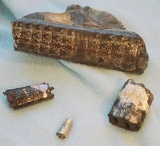
Baculitidae
Encyclopedia
Baculitidae is a family of extinct ammonoid cephalopods that lived mostly during the Late Cretaceous
Late Cretaceous
The Late Cretaceous is the younger of two epochs into which the Cretaceous period is divided in the geologic timescale. Rock strata from this epoch form the Upper Cretaceous series...
, and often included in the suborder Ancyloceratina
Ancyloceratina
The Ancyloceratina were a diverse suborder of ammonite most closely related to the ammonites of order Lytoceratina. They evolved during the Late Jurassic but were not very common until the Cretaceous period, when they rapidly diversified and become one of the most distinctive components of...
.
Baculitid genera are characterized by a small to minute initial coil of about two whorls followed by a long straight or slightly curved shaft. Genera are distinguished on the basis of size, general shape, particulars of the suture, and ornamentation. The genus Baculites has a large number of recognized species of which many if not most may be synomymous.
Related families are the Anisoceratidae
Anisoceratidae
Anisoceratidae is an extinct family of heteromorph ammonoid cephalopods.-Referenceas:*http://paleodb.org/cgi-bin/bridge.pl?action=checkTaxonInfo&taxon_no=96545&is_real_user=1...
, Diplomoceratidae, Hamitidae, Nostoceratidae
Nostoceratidae
Family Nostoceratidae was a diverse group of heteromorph ammonites found throughout the oceans of the world during the Late Cretaceous. The nostoceratids are famous for the bizarre coiling of their shells...
, and Turrilitidae
Turrilitidae
Turrilitidae is a family of extinct heteromorph ammonite cephalopods. All members had shells that coiled helically that tended to resemble auger shells....
; all of which along with the Baculitidae are included in the superfamily Turrilitaceae
Turrilitaceae
The Turrilitacaeae is a diverse superfamily of Cretaceous ammonites generally considered as heteromorphic and commonly included in the suborder Ancyloceratina...
.

